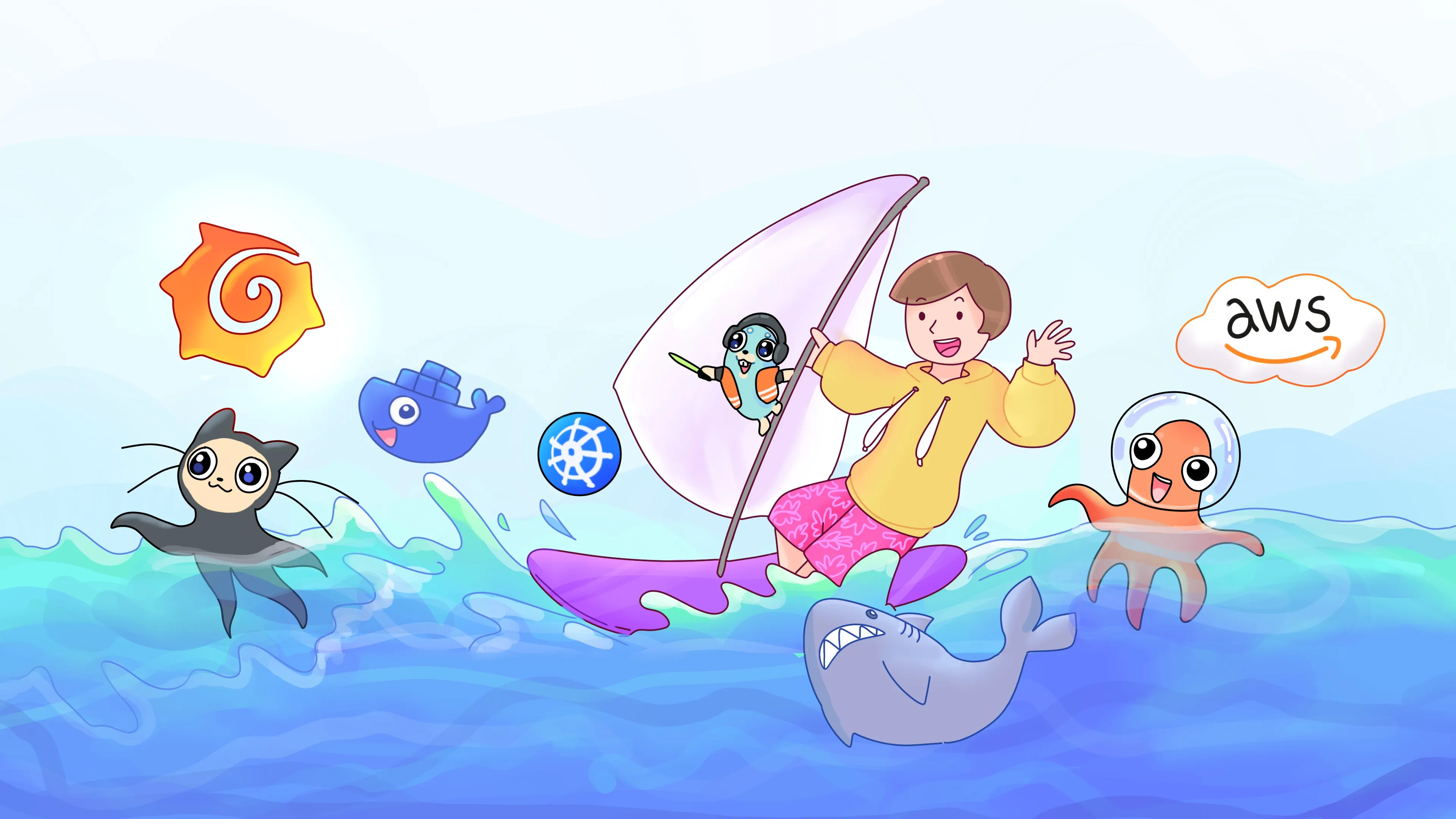Master Container Security in 2025 - Best Practices & Live Demo

Today, we’re diving into must-know container security strategies—practical steps to protect your applications, secure your supply chain, and stay ahead of evolving threats.
Now, we’re in 2025, and cybersecurity threats are more frequent, more sophisticated, and more damaging than ever. We’re no longer just worried about compromised servers or stolen databases—container security is now front and center. In fact, over 85% of organizations currently run containerized applications in production.
But as container adoption grows, so do the security risks—and attackers have noticed. That’s why it’s important for all of us—DevOps engineers, security professionals, developers, and system designers—to focus on container security.
In this article, we’ll dive into:
- Why container security matters in 2025
- Key best practices that every team should follow
- Practical examples using Docker Scout for local scanning and Snyk for continuous security checks in GitHub Actions.
So, let’s jump in—time is short, and security waits for no one!
Container Security in 2025
So why does container security matter in 2025? Let’s set the stage. In 2025, microservices are everywhere. Our applications might be composed of dozens or hundreds of containers, all talking to each other. This dramatically increases our attack surface.
Why? Each container is effectively its own environment—with OS packages, libraries, and configurations. If just one container is misconfigured or running unpatched software, that single weakness can lead to a major breach.
We’re also seeing a rise in supply chain attacks—a scenario where attackers don’t just target your code, but any external dependencies, base images, or third-party integrations you rely on.
In other words, the container image itself can be a point of compromise. That’s why we need to focus on:
- What’s in our base image
- Our runtime environment
- The pipeline that builds and ships these containers
My goal today is to give you a practical approach to shift security left—catching issues early in development, where they’re cheaper to fix, and integrating security checks into your day-to-day workflows
Key Best Practices in Container Security
So what are the best practices for securing containers? Let’s walk through seven core principles that apply to Docker, Kubernetes, and any containerized environment.
1. Use Minimal Base Images
Larger images mean more dependencies—and that means a bigger attack surface for attackers. Whenever possible, use lightweight images like Alpine or distroless instead of full Linux distributions.
Why? Alpine is only about 5 megabytes, compared to Ubuntu or Debian, which are tens or even hundreds of megabytes.
Fewer packages mean fewer security risks and a smaller attack surface—which is exactly what we want.
2. Pin Your Versions
When pulling an image, never just write:
FROM python:3Be specific—like:
FROM python:3.13.2-alpineThis locks in a stable version and prevents surprises from unexpected updates or security issues. And never use latest as a tag! If you pull FROM python:latest, you don’t know what version you’re getting—it could change unpredictably and break your app.
Even worse, an attacker could upload a compromised image under latest, and your system might automatically pull it without you realizing.
Always pin your versions to stay in control.
3. Scan Early and Often
Security isn’t a one-time step—you need to continuously scan for risks at every stage:
✅ Development
✅ Staging
✅ Production
Tools like Docker Scout and Snyk help automate this.
For example, with Docker Scout, you can scan an image with just one command and instantly see security risks.
Integrate security into your pipeline from day one — not as a last-minute patch.
4. Use Multi-Stage Builds
If your container has unnecessary dependencies, libraries, or tools left over from the build process, attackers have more to work with.
Instead, use multi-stage builds: Build your app in one stage, then copy only the necessary files to a final, smaller image.
This removes:
🚫 Debugging tools
🚫 Compilers
🚫 Temporary files
That means a smaller, cleaner, and more secure container.
5. Drop Unnecessary Privileges
By default, containers run as root, which is a huge security risk. If an attacker gains control of a root container, they can spread across your system.
Instead, run your container as a non-root user by specifying:
USER 1000:1000But what does this actually mean?
- The first one thousand is the user ID—it’s just a regular non-root user in Linux.
- The second one thousand is the group ID—which means it’s part of a restricted group.
By running as a low-privilege user, even if an attacker breaks in, they won’t have system-wide access.
6. Keep Secrets Out of Images
Never bake sensitive data inside an image—this is a common mistake that exposes secrets if your image is leaked or pulled by the wrong person.
Instead, store secrets securely in:
✅ Environment variables
✅ A secrets manager like AWS Secrets Manager, HashiCorp Vault, or Kubernetes Secrets
If you happen to hard-code a secret, tools like TruffleHog or GitLeaks can detect it before it gets exposed.
Never put secrets in images, repos, or logs!
7. Monitor Runtime Behavior
Scanning at build time isn’t enough—you also need to monitor what’s happening in production.
Tools like Falco and Sysdig can detect suspicious activity inside containers.
For example, Falco can alert you if a container suddenly starts running a shell, which could mean an attacker has taken control.
Watch out for other red flags like:
🚨 Unexpected file modifications
🚨 High network activity from a container
🚨 Containers trying to escalate privileges
By monitoring runtime behavior, you can catch threats before they become full-blown security incidents.
Final Thoughts on Key Best Practices in Container Security
If you follow these seven core principles, you’ll be ahead of many organizations that are still struggling with container security.
Less is more—less complexity, lower privileges, and minimal secrets make for a more secure container.
Docker Scout for Local Image Scanning
Alright, let’s roll up our sleeves and try out Docker Scout in action!
Docker Scout scans your Docker images for security issues and gives best-practice recommendations.
Before we start, make sure you have:
- Docker Desktop 4.38 or later installed
- A Docker Account, and that you’re signed in using
docker login
Now, let’s say we have a sample Node.js application. Here’s what our Dockerfile looks like.
# Use a lightweight Node.js image based on Alpine LinuxFROM node:22.13.0-alpine
# Set the working directory inside the containerWORKDIR /usr/src/app
# Copy only the package files first (for efficient layer caching)COPY package*.json ./
# Install Node.js dependenciesRUN npm install
# Copy the entire project (including index.js) into the containerCOPY . .
# Expose port 3000 for the Node.js serverEXPOSE 3000
# The default command to run the appCMD ["node", "index.js"]Here, we’re using node:22.13.0-alpine because it’s smaller than node:22. That makes it more efficient for containers, but we still need to check for security issues.
Now, let’s build our Docker image.
docker build -t my-node-app:1.0.0 .This command packages our application into a Docker image called my-node-app with version 1.0.0.
Next, let’s use Docker Scout to scan our image for security issues.
docker scout cves my-node-app:1.0.0Docker Scout will now analyze the image and highlight any potential risks or weaknesses.
Once the scan completes, we’ll see a report listing any detected issues, their severity, and possible fixes.
These issues could come from system libraries, base packages, or application dependencies. Docker Scout might recommend upgrading certain components or applying patches to fix them.
So why does this matter? Because local scanning helps us catch security issues early—before we push the image to a registry or deploy it to production. Fixing these issues now makes our environment instantly more secure.
And that’s a quick look at how you can use Docker Scout to improve security in your containerized applications.
Snyk in GitHub Actions
Now, let’s see how we can automate security scanning in our CI/CD pipeline using Snyk and GitHub Actions.
Before we start, make sure you:
-
Sign up for a free Snyk account at snyk.io.
-
Go to your Snyk account settings page, find your Access Token (Key), and copy it.
-
In your GitHub repo, go to Settings → Secrets and variables → Actions, and create a new secret named
SNYK_TOKEN.
Let’s say we have a Node.js project. Our goal is simple: whenever a developer pushes code or opens a pull request, we want Snyk to scan for security issues automatically.
- Snyk will check the container image to detect risks in the base image and OS packages.
- It will also check application dependencies to find security flaws in
package.jsonand other libraries.
Create a GitHub Action Workflow
To set this up, we need to create a new GitHub Actions workflow file. We’ll put it inside the .github folder, then workflows, and name it snyk.yml.
name: Snyk Security Scan
on: push: branches: ["main"] pull_request: branches: ["main"]
jobs: security: runs-on: ubuntu-latest steps: - name: Check out the repository uses: actions/checkout@v2
- name: Set up Docker Buildx uses: docker/setup-buildx-action@v2
- name: Build Docker image run: docker build -t my-node-app:1.0.0 .
- name: Snyk Container Scan uses: snyk/actions/docker@master env: SNYK_TOKEN: ${{ secrets.SNYK_TOKEN }} with: image: "my-node-app:1.0.0" args: "--file=Dockerfile"
- name: Snyk Code & Dependency Scan uses: snyk/actions/node@master env: SNYK_TOKEN: ${{ secrets.SNYK_TOKEN }} with: args: "--file=package.json"This workflow automatically scans both our Docker image and application dependencies for security risks. Here, we’re using SNYK_TOKEN from GitHub Secrets. This is a best practice because it keeps our login details safe and prevents accidental leaks.
Wrap-Up and Final Tips
We’ve covered a lot today:
- Why container security matters in 2025
- Seven core principles—from minimal images to least privilege
- A live demo of Docker Scout for local image scanning
- How to automate security scans using Snyk in GitHub Actions
But here’s the key takeaway: Container security isn’t just about tools or settings—it’s a mindset. Everyone on your team plays a role in keeping things secure.
Before we wrap up, here are some quick, practical tips to improve your container security:
- Monitor runtime with tools like Falco or Sysdig to detect suspicious activity.
- Keep everything up to date—patching OS packages and dependencies is one of the simplest and most effective security steps.
- Enforce security policies, like blocking deployments if there are serious security issues. A single rule like this can make a big impact.
- Educate your team—security isn’t just for DevOps or engineers; it’s a shared responsibility across developers, QA, and security teams.
Thank you for reading! Don’t forget to check out the video version for additional insights and visuals.
Patreon Exclusives
🏆 Join my Patreon and dive deep into the world of Docker and DevOps with exclusive content tailored for IT enthusiasts and professionals. As your experienced guide, I offer a range of membership tiers designed to suit everyone from newbies to IT experts.
Tools I Personally Trust
If you’re building, breaking, and trying to keep your digital life sane (like every good DevOps engineer), these are tools I actually use every day:
🛸 Proton VPN (60% off link) - my shield on the internet. Keeps my Wi-Fi secure, hides my IP, and blocks trackers. Even on sketchy café Wi-Fi, I’m safe.
🔑 Proton Pass (50% off link) - my password vault. End-to-end encrypted logins, 2FA, and notes - all mine and only mine.
🦑 GitKraken Pro (50% off link) - my visual Git sidekick. Beautiful commit graph, easy merges, and fewer “WTF just happened?” moments.
💜 These links give you discounts - and help support the channel at no extra cost.
Gear & Books I Trust
📕 Essential DevOps books
🖥️ Studio streaming & recording kit
📡 Streaming starter kit
Social Channels
🎬 YouTube
🐦 X (Twitter)
🎨 Instagram
🐘 Mastodon
🧵 Threads
🎸 Facebook
🦋 Bluesky
🎥 TikTok
💻 LinkedIn
📣 daily.dev Squad
✈️ Telegram
🐈 GitHub
Community of IT Experts
👾 Discord
Refill My Coffee Supplies
💖 PayPal
🏆 Patreon
🥤 BuyMeaCoffee
🍪 Ko-fi
💎 GitHub
⚡ Telegram Boost
🌟 Bitcoin (BTC): bc1q2fq0k2lvdythdrj4ep20metjwnjuf7wccpckxc
🔹 Ethereum (ETH): 0x76C936F9366Fad39769CA5285b0Af1d975adacB8
🪙 Binance Coin (BNB): bnb1xnn6gg63lr2dgufngfr0lkq39kz8qltjt2v2g6
💠 Litecoin (LTC): LMGrhx8Jsx73h1pWY9FE8GB46nBytjvz8g
Is this content AI-generated?
No. Every article on this blog is written by me personally, drawing on decades of hands-on IT experience and a genuine passion for technology.
I use AI tools exclusively to help polish grammar and ensure my technical guidance is as clear as possible. However, the core ideas, strategic insights, and step-by-step solutions are entirely my own, born from real-world work.
Because of this human-and-AI partnership, some detection tools might flag this content. You can be confident, though, that the expertise is authentic. My goal is to share road-tested knowledge you can trust.

